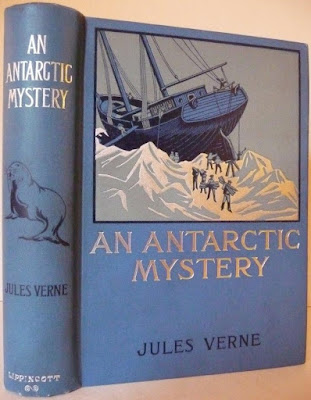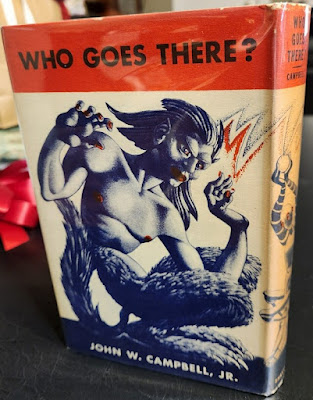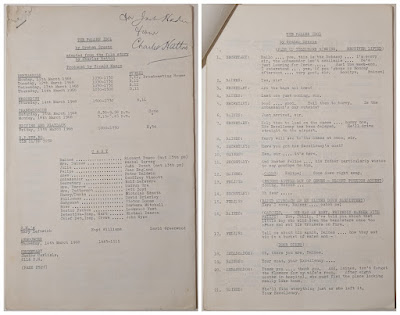Pre-1960 Science Fiction materialized as the topic for the December 2024 meeting. Offerings ranged from some of the most recognizable science fiction classics to little-known, mostly forgotten stories.
The featured books are presented here in chronological order of their original publication date.
 |
| A Journey to the Center of the Earth |
Verne, Jules. A Journey to the Center of the Earth. London: Griffith and Farran, 1872. First edition in English and first British edition. A Journey to the Center of the Earth was first published in French in 1864 as Voyage au centre de la Terre; a revised and expanded edition was issued in 1867. The first edition in English is one of the rarest of Jules Verne titles. This copy is in very good condition; it is beautifully rebound in full leather, probably by the first owner in the 1870s.
 |
| From the Earth to the Moon |
Verne, Jules. From the Earth to the Moon, Direct in Ninety-Seven Hours and Twenty Minutes: And a Trip Round It. New York: Scribner, Armstrong & Company, 1874. First American edition. The novel was first published in French as De la Terre à la Lune, trajet direct en 97 heures 20 minutes in 1865. From the Earth to the Moon was first translated into English in 1867. This copy in the original publisher's gilt illustrated binding is in good condition. Copies of From the Earth to the Moon are scarce in this attractive condition.
 |
| Twenty Thousand Leagues Under the Seas |
Verne, Jules. Twenty Thousand Leagues Under the Seas; or, The Marvellous and Exciting Adventures of Pierre Aronnax, Conseil His Servant, and Ned Land, a Canadian Harpooner. Boston: George M. Smith & Co., 1873. First American edition. The story was originally serialized in a biweekly French periodical, Magasin d'éducation et de récréation, from March 1869 through June 1870. Vingt Mille Lieues sous les mers was first published in book form in 1871, and first published in English as Twenty Thousand Leagues Under the Seas in 1872. This copy, in fine condition, retains the original publisher's gilt illustrated binding. Copies of this edition are scarce, and rare in such fine condition.
 |
| Looking Backward, 2000 – 1887 |
Bellamy, Edward. Looking Backward, 2000 – 1887. Boston: Houghton, Mifflin and Company, 1898. Memorial edition with an introduction by Sylvester Baxter. Looking Backward was first published in 1888 by Ticknor & Company. Following Bellamy's death in 1898, Houghton Mifflin released this memorial edition, ten years after the original publication, with Baxter's introduction. In 1888, the initial sales of Looking Backward were modest, but an enthusiastic review by Sylvester Baxter for the Boston Herald helped boost sales of the book, leading to the second edition published in 1889 by Houghton Mifflin (which had purchased Ticknor & Co. during that time). This copy lacks its dust jacket and has some marks on the cover, but the pages are clean with no markings.
 |
| Ben-Beor |
Bien, H. M. Ben-Beor: A Story of the Anti-Messiah. Baltimore: Isaac Friedenwald Co., 1891. This obscure title is a science fiction pastiche to two classic texts, Lew Wallace's Ben Hur and Eugene Sue's The Wandering Jew. Ben-Beor is divided into two parts. Part I: Lunar Intaglios: The Man in the Moon, is a "counterpart" to Wallace's Ben Hur, in which the prophet Elijah journeys to the moon in a fiery chariot. Part II: Historical Phantasmagoria: The Wandering Gentile, is a "companion romance" to Sue's The Wandering Jew. This title is listed in Everett Bleiler's The Checklist of Fantastic Literature (1948). This copy is in good condition with mottling to the cloth at the edges; the cover title is bright in gilt, though the lettering is dulled along the spine.
 |
| The Time Machine and The Invisible Man |
Wells, H. G. The Time Machine: An Invention. Norwalk, CT: Easton Press, 1986. Leather-bound with gilt decoration. Wells's time travel story began as a series of loosely connected, fictionalized essays published in National Observer in 1894 but was not completed. Wells reworked the story and serialized it in The New Review from January to May 1895. It was published in book form in the United States on May 7, 1895, followed by the British edition on May 29, 1895. There are textual differences between the two first editions; it is possible they were prepared from different manuscripts. Nearly all modern reprints follow the British text.
Wells, H. G. The Invisible Man. Norwalk, CT: Easton Press, 1967. Leather-bound with gilt decoration and "Invisible" blind stamped on front cover. The Invisible Man was originally serialized in 1897 in Pearson's Weekly and published in book form later that year.
 |
| An Antarctic Mystery |
Verne, Jules. An Antarctic Mystery. Philadelphia: J. B. Lippincott Company, 1899. First American edition. The story was first published in French as Le Sphinx des glaces (The Sphinx of the Ice Fields) in 1897. It was first translated into English and retitled as An Antarctic Mystery in 1898; this English edition was translated by Mrs. Cashel Hoey. Verne wrote An Antarctic Mystery as an original sequel to Edgar Allan Poe's The Narrative of Arthur Gordon Pym (1838). This copy in the original publisher's silver and white illustrated binding is in fine, virtually as-new, condition. The steel blue cloth with silver gilt and white cover illustration evokes a sense of the cold Antarctic ice.
 |
| An Antarctic Mystery |
Verne, Jules. An Antarctic Mystery. Philadelphia: J. B. Lippincott Company, 1900. A subsequent printing, published one year after the first edition with a newly designed cover. This edition contains 17 black and white illustrations on glossy stock. This copy is in good condition; it lacks the dust jacket, but the interior is clean with no markings.
 |
| The House on the Borderland |
Hodgson, William Hope. The House on the Borderland & Other Novels. Sauk City, WI: Arkham House, 1946. This posthumous edition collects Hodgson's four major novels: The Boats of the "Glen Carrig" (1907), The House on the Borderland (1908), The Ghost Pirates (1909), and The Night Land (1912). The dust jacket artwork is by Hannes Bok.
 |
| A Voyage to Arcturus |
Lindsay, David. A Voyage to Arcturus. New York: The Macmillan Company, 1963. This story was first published in 1920 after Lindsay agreed with his publisher to change the title and cut approximately 15,000 words from the text. The book sold poorly when it was first released; only 596 copies sold out of the first print run of 1,430. It did not sell well during his lifetime, but a second edition was published in 1946 shortly after Lindsay's death. That edition sold well, and the book became highly influential as a sci-fi classic. A Voyage to Arcturus was a major literary influence for C. S. Lewis's The Space Trilogy (see below). This 1963 edition is the first reprinting after the 1946 rerelease.
 |
| Skull-Face and Others |
Howard, Robert E. Skull-Face and Others. Sauk City, WI: Arkham House, 1946. Robert Howard was the creator of Conan, Red Sonja and several other characters published in pulp magazines. Skull-Face, the titular story in this collection, was originally serialized in Weird Tales magazine from October 1929 through December 1929. This book was his third posthumously published omnibus. The dust jacket artwork by Hannes Bok.
 |
| Who Goes There? |
Campbell, Jr., John W. Who Goes There? Chicago: Shasta Publishers, 1948. The novella was originally published in the August 1938 issue of Astounding Science Fiction magazine. Campbell used the pseudonym Don A. Stuart since he was the editor of Astounding. The story was adapted to film in 1951 by Howard Hawks as The Thing from Another World, and again more accurately in 1982, as The Thing, by John Carpenter. A prequel movie was released in 2011. In 2018, a longer version of the story titled Frozen Hell was discovered in John Campbell’s archives. A crowd-funded campaign allowed this new version to be published under the original Frozen Hell title. The dust jacket artwork for this 1948 edition is by Hannes Bok.
 |
| The Space Trilogy |
Lewis, C. S. The Space Trilogy: Out of the Silent Planet, Perelandra, and That Hideous Strength. Norwalk, CT: The Easton Press, 2003. Three volumes. Out of the Silent Planet, the first book in The Space Trilogy, was first published in 1938. Perelandra, the second book, was published in 1943. That Hideous Strength, the third book, was published in 1945. This three-volume edition is leather-bound with gilt decoration.
 |
| The Tortured Planet |
Lewis, C.S. The Tortured Planet. New York: Avon, 1958. First thus. The Tortured Planet is an abridgement of That Hideous Strength (1945) shortened by the author. This abridgement is also the first paperback edition.
 |
| Sixth Column |
Heinlein, Robert A. Sixth Column. New York: Gnome Press, 1949. First thus. This novel was first published under Heinlein's pseudonym Anson MacDonald in Astounding Science Fiction from January to March 1941. In the story, the USA is conquered by Asia, and a small group of scientists schemes to re-establish the country. This copy is in fine condition with its original dust jacket in vivid red and yellow with no fading.
 |
| Rocket Ship Galileo |
Heinlein, Robert A. Rocket Ship Galileo. New York: Charles Scribner’s Sons, 1947. First edition. Rocket Ship Galileo was the first in a series of 12 classic science fiction novels written by Heinlein for the young adult market. The 1950 movie Destination Moon directed by George Pal was loosely based on this novel and is considered one of the first “serious” science fiction films. This copy is in near fine condition with its original dust jacket.
 |
| Space Cadet |
Heinlein, Robert A. Space Cadet. New York: Charles Scribner’s Sons, 1948. First edition. Space Cadet is the second in a series of 12 classic science fiction novels written by Heinlein for the young adult market. The early television series Tom Corbett, Space Cadet (1950 – 1955) was very loosely based on this novel. This copy is in very good condition with its original dust jacket.
 |
| Red Planet |
Heinlein, Robert A. Red Planet. New York: Charles Scribner’s Sons, 1949. First edition. Red Planet is the third in a series of 12 classic science fiction novels written by Heinlein for the young adult market. The novel was adapted by Gunther-Wahl Productions into an animated miniseries for Fox Kids in 1994. This copy is in near fine condition with its original dust jacket.
 |
| What Mad Universe |
Brown, Frederic. What Mad Universe. Norwalk, CT: The Easton Press, 1986. This story was first published in 1949. The novel humorously satirizes the conventions of American pulp science-fiction of the 1940s while simultaneously incorporating those stereotyped elements into its own story. This satirical style creates an alternate universe in which, for example, recognizable sci-fi works such as H. G. Wells's The War of the Worlds is flipped to become a factual political argument condemning the human colonization of Mars. This edition is leather-bound with gilt decoration.
 |
| Worlds Beyond |
Knight, Damon, ed. Worlds Beyond, Volume 1, Number 1. New York: Hillman Periodicals Inc., December 1950.
. Worlds Beyond, Volume 1, Number 2. New York: Hillman Periodicals Inc., January 1951.
. Worlds Beyond, Volume 1, Number 3. New York: Hillman Periodicals Inc., February 1951.
Worlds Beyond was a short-lived science-fantasy fiction magazine producing only three volumes from December 1950 to February 1951. It was edited by science fiction writer Damon Knight and included sci-fi stories by contemporary genre writers such as William F. Temple, C. M. Kornbluth, Jack Vance, William Tenn, Harry Harrison, Lester del Rey, and Poul Anderson. Most of the stories were reprinted from other sources, but some were new stories making their first appearance in print. The third issue contains the debut of Harry Harrison's "Rock Diver," which popularized the sci-fi concept of matter penetration, or the ability to pass through solid objects.
 |
| Player Piano |
Vonnegut, Kurt Jr. Player Piano. Norwalk, CT: The Easton Press, 2004. This story was first published in 1952. Player Piano is Vonnegut's first novel. It was nominated in 1953 for the International Fantasy Award. In 1954 it was released in paperback and retitled Utopia 14 in an attempt to reach more sci-fi readers. This edition is leather-bound with gilt decoration.





















































